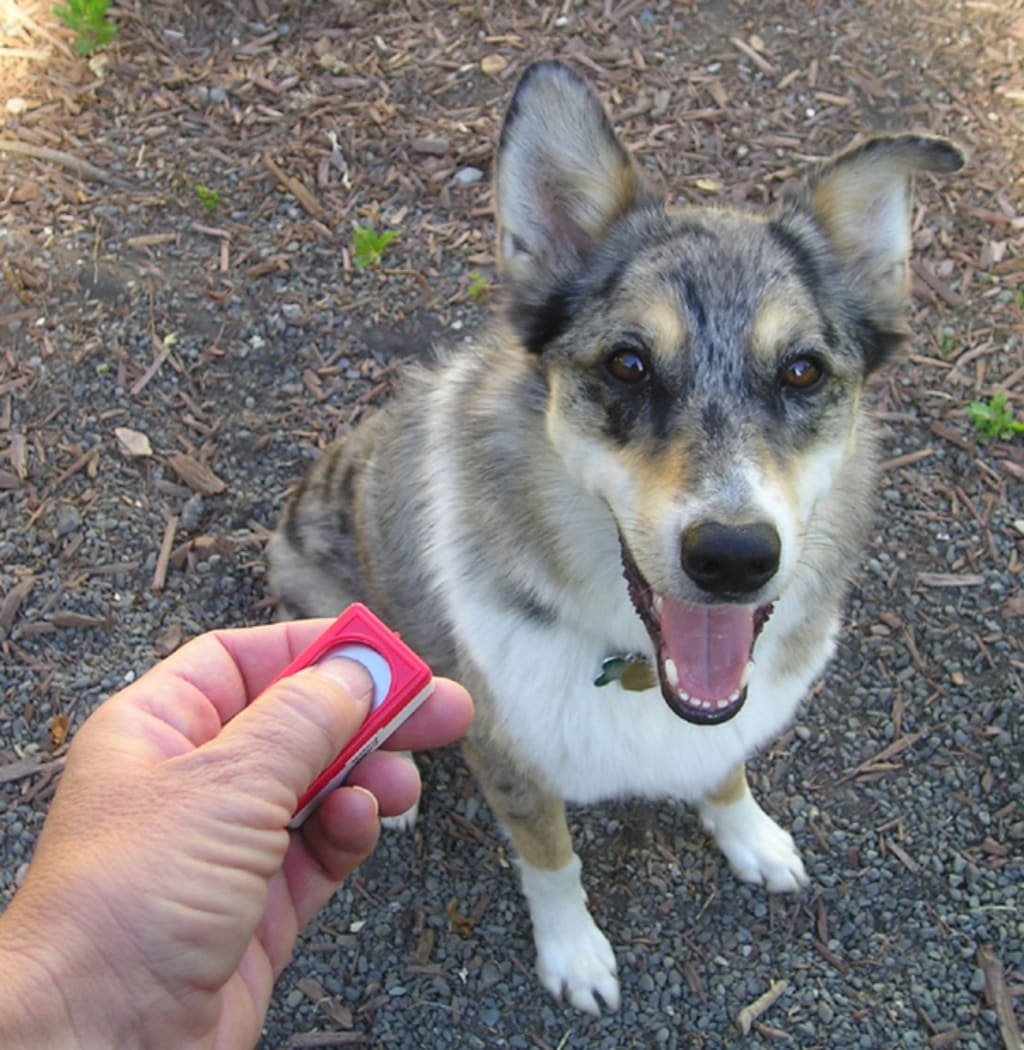Classical Conditioning - The Simple Guide
Because training dogs properly doesn't have to be complicated!

Classical conditioning. It can be overwhelming to someone who thinks training dogs is all about yelling at them when they're bad and giving them tasty stuff when they're good.
Unfortunately that isn't all there is to it. There is a heck of a lot more for you to understand if you really want to make the most of training sessions with Fido.
Briefly, classical conditioning includes the following:- Positive and negative reinforcement, and positive and negative punishment. Already you might be glazing over, or panicking that it sounds more than you've bargained for. Or you might be a clever sod who knows all this already. If so, feel free to glaze over now.
Let's break it down into sections for you ...
Positive Reinforcement
Put simply, this is where we bribe the dog to do what we want. We use it from the moment we bring our dog home as a puppy. We show the dog that the behaviour is good and worth repeating by giving him a reward. Because dogs learn best from anticipating a reward or by remembering a certain sequence of events triggered a good thing, you can see why positive reinforcement is so appealing. They do something good and they get a nice reward for it. Dogs don’t forget that.
Positive reinforcement usually works in the following sequence:
- Owner issues a command (e.g “Sit!”)
- Dog responds
- Owner gives a "bridge" (A clicker or verbal praise to let the dog know good things are coming)
- Owner gives reward
The bridge is very useful during positive reinforcement when used properly. It marks the moment the dog does what you ask of him, so gives you a little extra time to get to the reward. Essentially, it's linking the behaviour to a treat, hence the word "bridge."
In time, the dog will see the bridge as rewarding as the treat. He’ll be looking to the clicker to know he’s done what he was meant to, or the verbal praise, so you might not always need the treat.
Getting the timing of the bridge right is crucial. Try to stick to a “five-second rule” — the dog must perform the behaviour, and you must give the bridge within the space of five seconds.
Any longer will give the dog chance to perform another behaviour, and you could inadvertently reward him for the wrong thing! To make this clearer, your dog might sit down. You fumble around in your pocket for ten seconds looking for the clicker or treat, and during this time your dog has got bored and stood up again, or has started sniffing around. You end up marking and rewarding the wrong behaviour. So take care, have all treats and markers/bridges to hand, and reward the behaviour you want.
Remember that verbal praise can be a good bridge as well, especially if your dog doesn’t take to the clicker.
Another important part of positive reinforcement is the value of your “motivator” – your “motivator” is your dog’s reward for good behaviour. Getting a high-value motivator is very important when your training is aiming to stop your dog from doing something (such as chasing cars, lunging at other dogs, stealing your underwear etc.) What you’re offering your dog needs to be much more valuable than the reward he’d get if he accomplishes his bad behaviour.
In short, make him an offer he can’t refuse! [Examples of positive reinforcement: praising him for returning when called; giving a treat when he sits].
Negative Reinforcement
Okay, this one might go over your head a bit but stay with me. I'll explain it as simply as I can.
This is when the dog must perform certain behaviours in order to remove a negative stimulus — in layman’s terms, a dog must do A to remove B, because A is a lot more appealing to him.
To make it clearer, we’ll use the use of shock collars and prong collars as an example. In this case, the collars will be unwanted situation “B”. The dog will learn that, in order to prevent “B” happening (the sensation of a shock/pinching sensation) he’ll have to perform “A” (a more desirable behaviour such as walking nicely on the lead, not barking at visitors etc.)
So, in negative reinforcement, a dog will perform a good behaviour in order to avoid a bad thing happening. When done properly, negative reinforcement can lead to a rise in good behaviour — the dog will learn to perform good behaviours through habit and, ultimately, because he wants to. But negative reinforcement should never be about a dog performing behaviours purely because he is scared of the alternatives.
At a stretch, negative reinforcement could also be manipulated and seen from a dog’s point of view to help us understand their behaviour a bit better; car chasers, for example, will see their behaviour of barking/lunging at cars as behaviour “A” that he must perform to get rid of negative situation “B”. Dogs can use negative reinforcement on their surroundings and, in their minds, they might think they’re the ones training the world! The same goes for those who bark at the postman; they’ve taught the postman to go away time and time again by barking. They don’t know he still has the whole street to deliver to – they think he’s frightened, and that they’ve trained him using their own brand of negative reinforcement.
Got it? I hope so.
Next ...
Positive Punishment
I know, it sounds contradictory. But it's actually very simple and understandable — positive punishment is simply when an undesirable behaviour is met with an undesirable response, making the undesirable behaviour less likely to happen in the future.
Dogs use positive punishment towards each other. Adult dogs often use it towards younger dogs to tell them they’ve overstepped the mark – the puppy might play-bite once too often, the adult dog will snap to tell them it’s unacceptable. The puppy will learn that he is not to bite because it is seen as a bad behaviour and will be less likely to repeat the behaviour in the future.
From a human’s point of view, positive punishment can include giving a strong, loud voice command for an undesirable behaviour.
Negative Punishment
Finally, on to the last bit of classical conditioning we may encounter during our training sessions: Negative punishment.
This is simply when the dog has something which he sees as positive removed from him because of bad behaviour. He performs an action, but in return has what he wants most removed from him. In future he’ll learn to not perform such an action again because the result is, in his mind, negative.
To put it another way and to give an example, the owner may be ready to take the dog out for a walk. The dog however will not cooperate – he might be noisy, not sit still long enough to allow the lead to be attached or might charge out of the door too fast. As a result the owner closes the door again, drops the lead and sits down and refuses to take him out for a walk until he is calm again.
The walk is something he desires, but his behaviour of barking/jumping up/charging out of the door is seen as bad behaviour – if the prospect of the walk is removed from him, it turns it into negative punishment. He will, in time, learn that in order to get what he wants most he must be calm.
All of the punishments and reinforcements mentioned above can come in handy when it comes to training sessions, but nobody here can tell you which is best. It is up to you to decide. If you have a skittish dog which was abused in the past, obviously you need to steer well clear of any conditioning which involves yelling or strong physical contact.
And it goes without saying — never, ever punish a dog physically during your training. Aggression only begets aggression, and the last thing you want is your dog to resort to biting to tell you: "Enough — I have feelings too!".
About the Creator
Lily Bloss
I have been writing non-fiction, fiction and poetry for as long as I can remember. It was a hobby encouraged by my Nan from an early age. For that, and so many other things, I thank you Nan xox






Comments
There are no comments for this story
Be the first to respond and start the conversation.